Last week I showed you the most exciting of the garments that Elise gave me. This week I’m being mean and showing you the simplest, least-exciting garment.
Well, it may be simple, but sometimes the simplest things are the best. I think this little cape-stole is adorable.
The cape is very cleverly made. It’s made from two pieces of fabric, with part of the back extending further, and the other part curving up around the neck. The extension is gathered to the neck-part to add back fullness:
The lining is cut in exactly the same shape as the outside, and also gathered at the upper back seam.
I think it is late ’30s, but I’m not entirely sure. It’s such a classic style it could really be from any timeperiod.
While it is charming and dressy, I suspect this would have been a very cheap garment when it was made. It’s made from a very short pile fabric which is somewhere between a faux fur and a synthetic velvet, and lined in an inexpensive synthetic taffeta lining. Synthetic fabrics were considerably cheaper than their natural fibre alternatives throughout the 30s and 40s. The pile of the faux fur is quite sparse and thin – indicating that the fabric was a particularly cheap, low quality synthetic.
Both the outside and lining fabric have foxing: an acid reaction that creates yellow spots.
Based on this, you might be thinking that I find this garment a bit disappointing, especially after something like the assuit tunic. And you’d be very wrong. While I love and appreciate the luxury of expensive, exotic, high society textiles like last week’s tunic gown, it’s simple, inexpensive garments like this that really have my heart.
This garment must have been so special to the person who owned and wore it. Perhaps it was a young girl’s first proper dress up wrap – worn to her first dances. Or the garment of a farm wife, who had few occasions to wear evening clothes, and could little afford to buy a pricey wrap she didn’t need.
Their story isn’t as glamorous as that of the Houston socialite, but it is, in it’s own way, much sweeter.

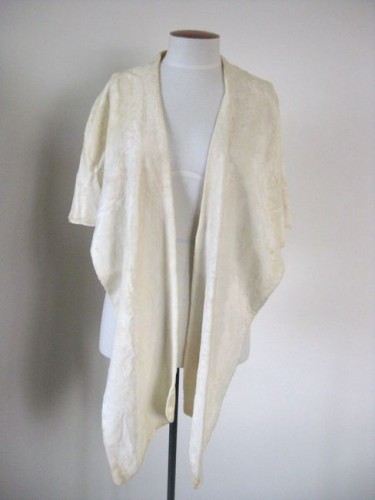
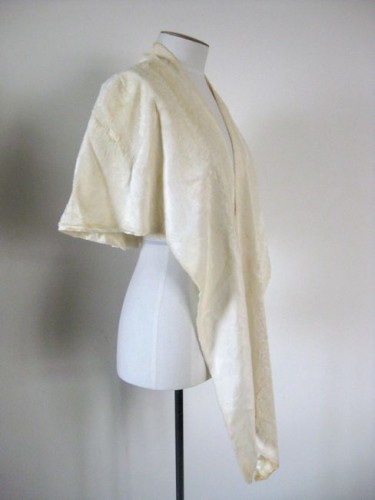
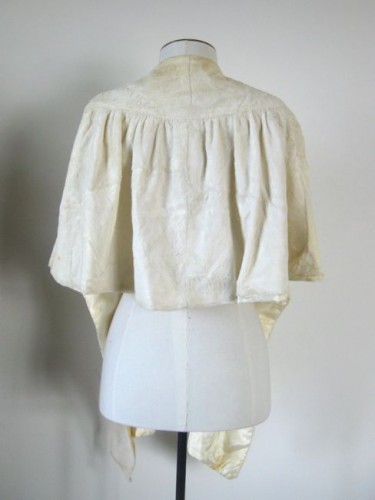

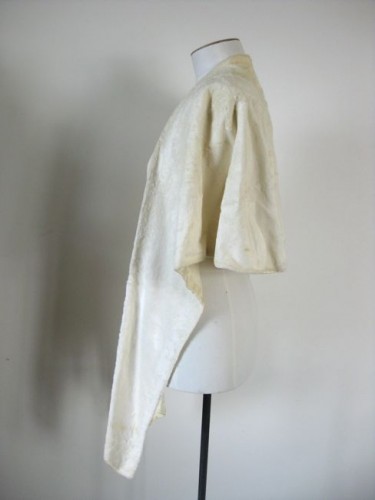

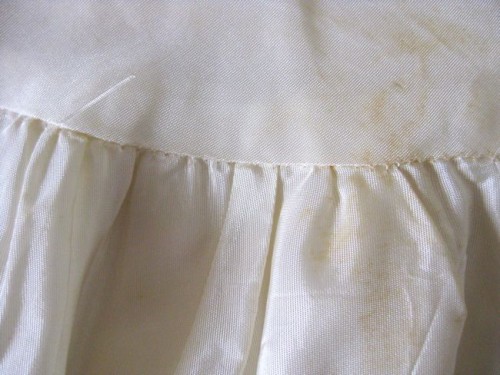
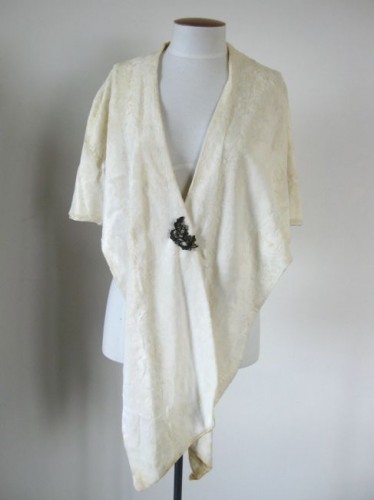

That is cute! One of the things I love about antique textiles is imagining who might have worn them before. I love the hight fashion couture from forever ago, but at the same time, when you have a piece of clothing from an everyday person, it’s almost that much more special–it’s like the speciality that those people felt is just added on to it, more so than a beautiful gown would be to someone who had a closet-full.
That’s exactly how I feel 🙂
I think it’s beautiful. In its own way I actually like it just as much as last week’s tunic (soon to be copied in black lace – just need to finish my partner’s trousers first). I think this stole would be absolutely stunning in silk velvet.
I was thinking just the same thing! It’s such a clever pattern.
I want to make a pattern from it now. You’re right, it’s classic and simple and interesting. Thank you for sharing.
Hi,
I think you’re correct with the 1930’s date. Very Cute.
I’ve found that MOST foxing and staining can be removed by a simple soak of hard water softener disolved in cold water, then the item of fabric or clothing added after the disolving and stirred in gently just so the fabric or clothing is wet, and left for an hour. then removed, the water gently squeezed from it (do not wring fabric) and a gentle rinse in indirect clean cold running water and the item hung to drip or flat dried, and a touch up with a low iron if necissary. something with a nap like this has would do better with a gentle use of a fingernail brush to raise and straiten the nap, and, at most, a light spray of water on the underside to remove deep wrinkles. I would not suggest ironing any faux or real velvet, it crushes the nap.
oh, and never use hard water softener on any material that has a natural oil in it, the softener removes oil and will destroy such things as flax, wool and silk. it’s ok on manmade materials, and cotton, but not natural fabric other than cotton. I’ve tried it on polished cotton and it does seem it removed the polish, but I can’t be certain of that memory-too many years back…
It *is* fun to imagine who might have worn it. All of us non-socialites maybe even imagine better: For all we know, it very well could have been one of us in another life, or one of our great-aunts.
Something else fun is that the clothes are so disparate that everyone can imagine a new person each time.
I almost wore the stole at my wedding, but I didn’t want to hurt it only to send. Besides, more people have fun with it, this way! We all get to share it.
Oh, and the brooch is charming.
…Awwww… it would have been lovely if you had worn it for your wedding! Despite the foxing, it’s quite robust. What a charming addition to the story.
Good point Elise. This is the kind of garment my grandmother might have owned. I can imagine her in it easily; it’s the kind of thing she would have liked.
We don’t often get to see ordinary people’s clothes, because they tended to get worn until they wore out or were reused for other garments, so I find it especially interesting to see ordinary people’s clothes when they do get preserved.
Hi Stella! Not that I mind looking at the ‘best’, but it is so much more interesting to represent everyone. Did your grandmother love clothes? Did she get to be an artist and make her own?
By the way, Dreamstress, the term ‘foxing’ is perfect!
I’m afraid I can’t claim credit – it’s the proper art/museum term for those little brown spots. 🙂
Hi! Yes and yes. She was as stylish as she could be on the budget she had, and worked as a tailor for a while.
A treasure! And a reproducible treasure.
Indeed!
I too would very much like to sincerely flatter this little gem by imitating it! To which end, would you possibly be willing to help a girl out and perhaps post a couple more photos fully showing the construction lines?
I also agree that silk velvet would be divine – or even a vintage viscose velvet which is also plush with great drape, and of which I have some! Silk charmeuse with an underlining for added body and substance would also be delicious. Yum, yum!
Pretty please?